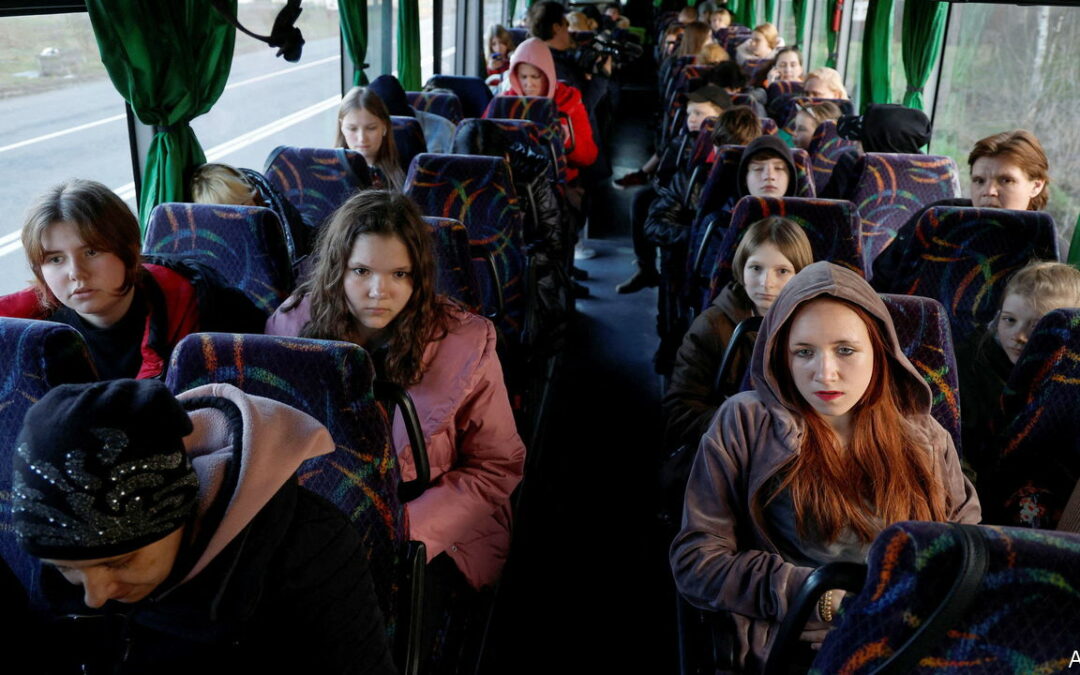RUSSIA IS LED by an alleged war criminal. In March the International Criminal Court (ICC) issued arrest warrants for President Vladimir Putin as well as Maria Lvova-Belova, Russia’s so-called commissioner of children’s rights. The court says that the pair bear responsibility for two war crimes: the “unlawful deportation” and “unlawful transfer” of people—including children—from Russian-occupied territories of Ukraine into Russia (and Crimea, the Ukrainian peninsula Russia illegally annexed in 2014). Neither individual is likely to stand trial. But evidence that the president empowered Ms Lvova-Belova to set up a child-deportation programme is mounting. What is the Kremlin trying to achieve by abducting children?
A report by researchers at Yale University, published in February, gives a detailed account of Russia’s child-deportation campaign. By scouring social-media platforms, local-news reports and satellite images, the analysts uncovered a network of 43 Russian facilities to which Ukrainian children had been moved since February 2022. Many of the camps are in Crimea and southern Russia, close to Ukraine. But some are farther afield: one was identified in Magadan, a far-eastern region nearly 4,000km (2,500 miles) from the Ukrainian border. The researchers say that at least 6,000 children have been transferred to the camps, but the figure is probably far higher.
Sometimes, the study claims, Russia presents the facilities as recreational camps to parents, seeking to gain their (potentially forced) consent for children to travel. Guardians may wish to send infants out of the war zone, feel pressure from occupying forces to send them away, or simply believe that the camps offer children a free holiday. Some return home after an agreed-upon period. But the facilities may refuse to send them back, citing “safety concerns” (for example, if their parents live in territory that has been recaptured by Ukrainian forces). Some parents have had to travel to Crimea or Russia to recover their children.
The camps instil a Russo-centric worldview in the children. These educational programmes involve classes based on the Russian curriculum, talks from veterans and even military training. There are reports of psychological and physical abuse, too. One teenager who was reunited with his family in March after months at a facility in Crimea told Ukrainian media that children who expressed pro-Ukrainian sentiment were punished. He claimed to have seen a girl with bruising on her back, apparently caused by a beating.
“Re-educated” Ukrainian children, as the study calls them, contribute to the Kremlin’s propaganda campaign, which casts the Russian invasion as a liberation of Ukrainians from a Western-backed fascist regime. In February children deported from Mariupol, an occupied city in south-eastern Ukraine, appeared at a rally in Moscow celebrating the invasion’s first anniversary. A 15-year-old girl was chosen to “thank” the soldier who “saved” her from the city.
Parts of the camp network are designed to facilitate permanent displacement. The Yale researchers identified two Russian facilities involved in the deportation of infants who were under the care of the Ukrainian state before the invasion (be it in childrens’ homes or medical facilities). Russian officials say that many such children are orphans—a claim Ukraine denies—and that it is moving them into foster care with Russian families. But international-law treaties prohibit the forcible transfer of children between countries.
By indoctrinating children Mr Putin, who denies the reality of a discrete Ukrainian identity, hopes to inspire loyalty to Russia in the parts of Ukraine that he claims as his own. That is why he is empowering Ms Lvova-Belova to process the removal of minors to Russia. She has personally adopted a 15-year-old boy from Mariupol—and calls the ICC’s indictment a “farce without specifics”. ■









